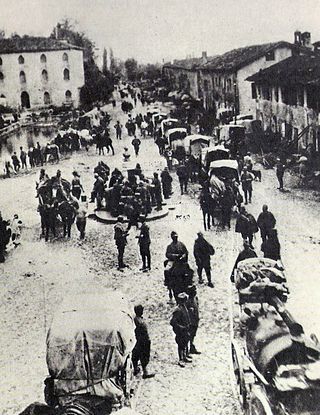
Svetozar Boroević von Bojna was an Austro-Hungarian field marshal of Croatian Serb descent who was described as one of the finest defensive strategists of the First World War. He commanded Austro-Hungarian forces in the Isonzo front, for which he was nicknamed the "Lion of Isonzo".

The Second Battle of the Piave River, fought between 15 and 23 June 1918, was a decisive victory for the Italian Army against the Austro-Hungarian Empire during World War I, as Italy was part of the Allied Forces, while Austria-Hungary was part of the Central Powers. Though the battle proved to be a decisive blow to the Austro-Hungarian Empire and by extension the Central Powers, its full significance was not initially appreciated in Italy. Yet Erich Ludendorff, on hearing the news, is reported to have said he 'had the sensation of defeat for the first time'. It would later become clear that the battle was in fact the beginning of the end of the Austro-Hungarian Empire.

The Battle of the Vistula River, also known as the Battle of Warsaw, was a major Russian victory against the German Empire and Austria-Hungary on the Eastern Front during the First World War.

The Battle of Kraśnik started on August 23, 1914, in the province of Galicia and the adjacent areas across the border in the Russian Empire, in northern Austria, and ended two days later. The Austro-Hungarian First Army defeated the Russian Fourth Army. It was the first victory by Austria-Hungary in World War I. As a result, the First Army's commander, General Viktor Dankl, was (briefly) lauded as a national hero for his success. The battle was also the first of a series of engagements between Austria-Hungary and Russia all along the Galicia front.

The Military Order of Maria Theresa was the highest military honour of the Habsburg monarchy, Austrian Empire and Austro-Hungarian Empire.

The Serbian campaign was a series of military expeditions launched in 1914 and 1915 by the Central Powers against the Kingdom of Serbia during the First World War.

The 42nd Home Guard Infantry Division, nicknamed the Devil's Division was an infantry division of the Royal Croatian Home Guard within the Austro-Hungarian Army which was active in World War I.

Liborius Ritter von Frank was an Austro-Hungarian general in World War I. He commanded the Austro-Hungarian Fifth Army in 1914 at the start of the war, and fought at the Battle of Cer, Battle of the Drina and Battle of Kolubara. He was replaced by General Karl Tersztyánszky von Nádas after the failure of the first Serbian campaign, the enormous casualties suffered by his army reduced to about 40% of its strength and the disbandment of the Balkanstreitkräfte.

The Battle of Gnila Lipa took place in early World War I on 29–30 August 1914, when the Imperial Russian Army invaded Galicia and engaged the defending Austro-Hungarian Army. It was part of a larger series of battles known collectively as the Battle of Galicia. The battle ended in a defeat of the Austro-Hungarian forces.

The Battle of Caporetto, took place from 24 October to 19 November 1917, near the town of Kobarid, on the Austro-Italian front of World War I. The battle was named after the Italian name of the town of Kobarid.

The leaders of the Central Powers of World War I were the political or military figures who commanded or supported the Central Powers.

Wenzel Freiherr von Wurm was a Colonel General in the Austro-Hungarian Army.

The 2nd Army, later designated East Army, was a field army-level command of Austro-Hungarian Army that was active during World War I. It was initially formed to take part in the Balkans Campaign before being transferred to the Eastern Front. In the final stages of the war, the army was evacuated from Ukraine before demobilizing in November 1918.

The 3rd Army was a field army-level command within the ground forces of Austria-Hungary during World War I. It was primarily active on the Eastern Front against the Russian Empire and in the Balkans against Serbia and Montenegro. Later on, the 3rd Army took part in some fighting on the Italian Front before returning to the eastern theater by 1917 to repulse the Kerensky Offensive. Its remaining units were merged with the 7th Army in January 1918.
Alfred Edler von Schenk was an Austrian general and later Czechoslovakian government advisor.
The Serbian campaign of 1914 was a significant military operation during World War I. It marked the first major confrontation between the Central Powers, primarily Austro-Hungary, and the Allied Powers, led by the Kingdom of Serbia. The campaign started on 28 July 1914, when Austria-Hungary declared war on Serbia and bombarded Belgrade. On 12 August, the Austro-Hungarian forces, led by General Oskar Potiorek, launched their first offensive into Serbia.

The Balkanstreitkräfte, also known as the Balkan Army, was the force raised by Austria-Hungary for its offensive action against Serbia in August 1914, at the start of World War I.

Ludwig Goiginger was an Austro-Hungarian Lieutenant Field Marshal who notably served in World War I.

Andreas Karl Franz Fail, from 1875 Fail-Griessler was an Austro-Hungarian General of Infantry. He was born 25 February 1857 in Graz and died 6 March 1919 in Graz. At the beginning of the First World War he was commander of the 32nd Infantry Troop Division in Syrmia during the Serbian campaign, then from September to November 1914 commanding general of the VII Army Corps, which during this time was deployed with the k.u.k. 2nd and 3rd Armies at the Carpathians.

Colonel General Adolf Freiherr von Rhemen zu Barensfeld, sometimes referred to as Baron Rhemen, was a German senior officer in the Austro-Hungarian Army, known for his commanding roles during the First World War.


















